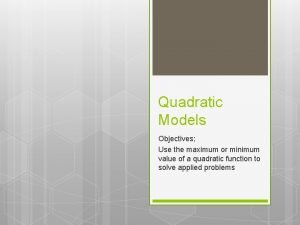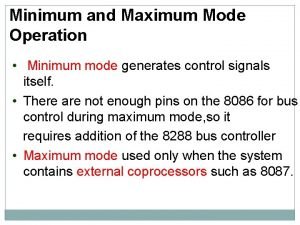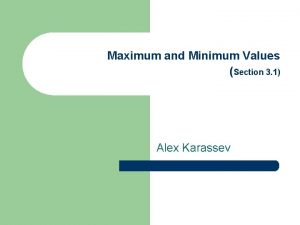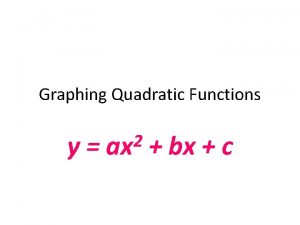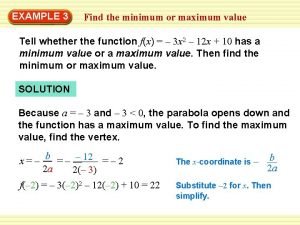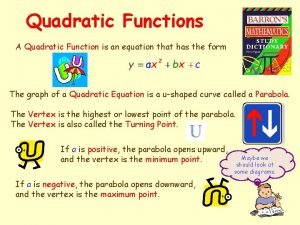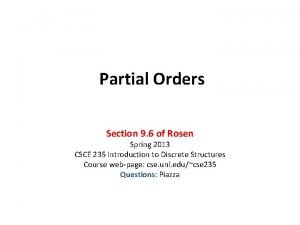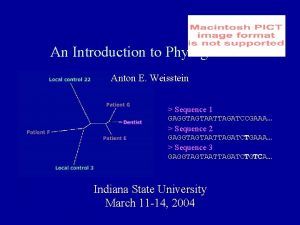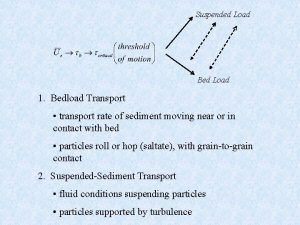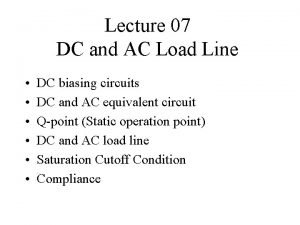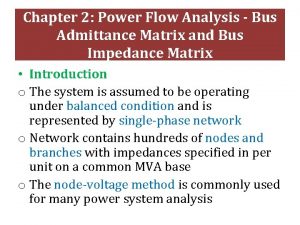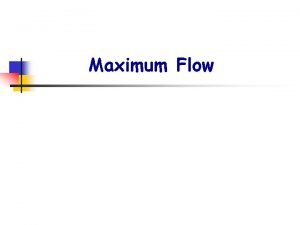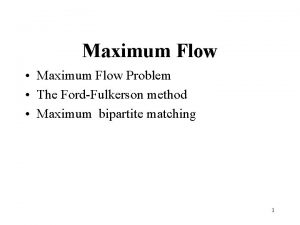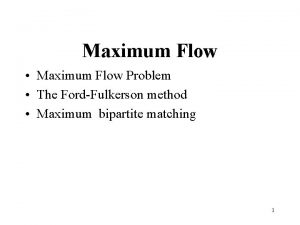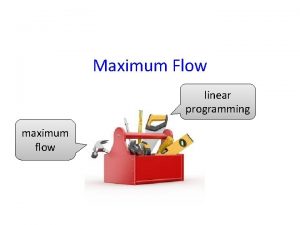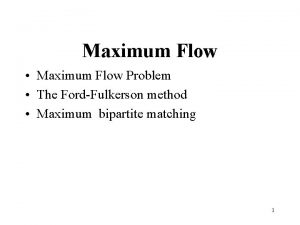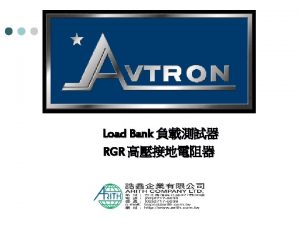Load flow study Maximum load flow study Minimum









































- Slides: 41




























Load flow study Maximum load flow study Minimum load flow study The economical study

Maximum Case Improvement 1. 05 Vnominal< V < 1. 1 Vnominal pf (load &capacitor) < 0. 96 lag The total power losses must decrease

The Result Of Load Flow: The following table shows the results after adding capacitors in order to improve the voltage levels. #of Bus Nominal Voltage after voltage improving the (KV) generators Bus#1 33 31. 73 Bus#2 Bus#3 Bus#4 Bus#5 Bus#6 Bus#7 Bus#8 Bus#9 33 33 33 22 31. 167 30. 522 31. 357 19. 566 31. 902 31. 632 31. 717 20. 312 voltage after changing the tap 32. 365 Voltage after adding the capacitors 33. 848 31. 819 31. 184 32. 007 20. 212 33. 023 32. 842 32. 757 21. 669 33. 411 32. 968 33. 499 21. 891 33. 58 33. 317 33. 401 22. 061

The swing bus result Swing Bus At beginning after improving the generators after changing the tap MW 232. 441 236. 369 Mvar 203. 828 202. 411 MVA 309151 311. 192 PF% 75. 19 75. 96 238. 728 202. 295 312. 912 76. 29 after adding the capacitors 239. 163 130. 615 273. 387 90. 01

The result of power losses Power losses= Apparent Losses/(Total Motor Load+Total Static Load))*100 ΔP at beginning =4. 495 ΔP after improving the generators =4. 04 ΔP after Changing the turns ratio of the transformers =3. 841 ΔP after adding the capacitors = 2. 85

Minimum Case Improvement 1 -Vact>Vnom at any Bus at low voltage side 2 -Pf (Load &capacitor) <0. 96 Lag at any Load Bus 3 -the total power losses must decrease

The Result Of Load Flow: The following table shows the results after adding capacitors in order to improve the voltage levels. #of Bus Nominal Voltage after voltage improving the (KV) generators Bus#1 33 31. 904 Bus#2 Bus#3 Bus#4 Bus#5 Bus#6 Bus#7 Bus#8 Bus#9 Bus#10 33 33 33 22 33 31. 69 31. 434 31. 76 20. 672 31. 975 31. 869 31. 975 20. 949 31. 352 voltage after changing the tap 32. 704 Voltage after adding the capacitors 33. 078 32. 492 32. 241 32. 562 21. 403 32. 773 32. 668 32. 701 22. 019 3. 16 32. 914 32. 665 32. 937 21. 968 32. 955 32. 883 22. 145 32. 389

The swing bus result Swing Bus after improving the generators MW 93. 322 Mvar 68. 809 MVA 115. 947 PF% 80. 49 after changing the tap after adding the capacitors 94. 262 69. 228 116. 954 80. 60 94. 455 50. 604 107. 156 89. 15

Benefits of Improving Power Factor: 1. Lower Apparent Power 2. Reduces losses in the transmission line 3. Improves voltage drop. 4. Avoiding the penalties The following table shows the system of the penalties in our companies: Power Factor P. F≥ 0. 92>P. F ≥ 0. 8>P. F≥ 0. 7 P. F <0. 7 P. F Penalties No Penalties. 1% of total bill for each one under 0. 92 1. 25%of total bill for each one under 0. 92 1. 5%of total bill for each one under 0. 92

The result of power losses ΔP after improving the generators =1. 53 ΔP after Changing the turns ratio of the transformers =1. 469 ΔP after adding the capacitors = 1. 23

Economical study This table shows the fixed capacitors and the regulated capacitors which used in minimum and maximum Load Bus Jenin Nabluse Tulkarm Max case Qc MVAR 15 18 12 Min case Qc MVAR 6 6 6 Sum of fixed cap =18 MVAR Sum of regulated cap =27 MVAR fixed cap. regulated cap Qc MVAR Qc. MVAR 6 6 6 9 12 6

The cost of fixed capacitor C 1=3500$/MVAR The cost of regulated capacitor C 2=7020$/MVAR Time of max losses T=4500 H The cost of real power losses CΔp=120 $/MWH Capital recover factor Eh=0. 22 Before ΔP(MW) 238. 728 ΔQ(MVAR) 202. 295 After ΔP(MW) 240. 163 ΔQ(MVAR) 130. 615 Capital cost Cc= fixed capacitor *C 1+ regulated capacitor *C 2 = 18*3500+ 27*7020 =252540$

The equivalent annual cost of capacitor =0. 22*252540 =55558. 8($/year) Percentage of the total reduced power losses ΔP%=P 1%-P 2% P 1% is the power Losses before any capacitors added P 1%=6. 56/(187. 376+42. 52) =3. 841 P 2%is the power losses after the capacitors added P 2%=8. 86/(187. 376+46. 041) =2. 85 ΔP%=3. 841 -2. 85 =0. 9

The total reduced power losses ΔP = ΔP%*Total power load after capacity =0. 9* (187. 376+46. 041)/100 =2. 1 MW The total reduced energy losses ΔΔP= ΔP*T 2. 1*4500=9453. 388 MW. H The annual cost of total reduced energy losses Z= ΔΔP*Cp 9453. 388*120 =1134406. 62$/year The total saving amount S=Z-EAC = 1134406. 62 -55558. 8 =1078847. 82 Pay pack period PP=CC/S =252540/ 1078847. 82 =0. 23 year 0. 23*12 =2. 8 month
 Local max
Local max Tentukan nilai maksimum dan
Tentukan nilai maksimum dan Quadratic word problems
Quadratic word problems Maximum and minimum values of quadratic functions
Maximum and minimum values of quadratic functions Relative maximum and minimum
Relative maximum and minimum Minimum mode of 8086
Minimum mode of 8086 Maximum value
Maximum value Minimum parabola
Minimum parabola Maximum value
Maximum value Derivative maximum and minimum
Derivative maximum and minimum What is the difference between maximum and minimum
What is the difference between maximum and minimum Minimum and maximum of a quadratic function
Minimum and maximum of a quadratic function An example of a quadratic function
An example of a quadratic function In clearance fit
In clearance fit Maximum metal condition
Maximum metal condition Minimum enthalpy and maximum entropy
Minimum enthalpy and maximum entropy Bellani-six thermometer
Bellani-six thermometer Topological ordering
Topological ordering Maximum likelihood vs maximum parsimony
Maximum likelihood vs maximum parsimony Maximum likelihood vs maximum parsimony
Maximum likelihood vs maximum parsimony Taper roller bearing advantages and disadvantages
Taper roller bearing advantages and disadvantages Load paths
Load paths Pux
Pux The point of intersection of d.c. and a.c. load lines
The point of intersection of d.c. and a.c. load lines Minimum cost flow
Minimum cost flow Minimum cost flow
Minimum cost flow Shortest path formulation
Shortest path formulation Baseball elimination problem maximum flow
Baseball elimination problem maximum flow Load flow analysis
Load flow analysis Bus matrix
Bus matrix Magic box oxygen therapy
Magic box oxygen therapy Cylinder oxygen
Cylinder oxygen Simple mask
Simple mask Definition of laminar flow and turbulent flow
Definition of laminar flow and turbulent flow Internal versus external flow
Internal versus external flow Ecological succession
Ecological succession Oikos meaning
Oikos meaning Transform flow and transaction flow
Transform flow and transaction flow Transform flow and transaction flow
Transform flow and transaction flow Irrotational flow means *
Irrotational flow means * Internal flow examples
Internal flow examples Data flow vs control flow
Data flow vs control flow



